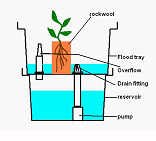To the intrepid gardener with not much precious space to spare, hydroponic gardening is a great way to fulfill that need to cultivate your own vegetable and plants in your home. Today there are many kits and do-it-yourself systems that an avid gardener can do to have themselves a hydroponic garden. All one needs to understand is how the basic need of a plant such as food, water and air come together to allow the plant to thrive.
DIY Hydroponics
For any newcomers to hydroponics gardening, the one question that constantly hovers over their mind is whether building a hydroponic system is difficult. The answer is no. With a little bit of know how, it is easy to create yourself a home made hydroponic system that will allow you to cultivate your own plants, be it herbs, flowers, tomatoes etc.
There are various systems used in hydroponic gardening, with all generally categorized into two types, passive and active. This is further divided into several types of system. These include: Flood and Drain (or Ebb and Flow), Deep Water Culture (DWC), Drip feeding, Wick feeding, Nutrient Film Technique (NFT), and Aeroponics. This article touches on the construction of a DIY Flood and Drain system or also known as an Ebb and Flow system
The Ebb and Flow System
The Ebb and Flow is a system suitable for both beginners and experts alike. It basically uses a submersible pump in a reservoir that pumps nutrient solution into a flood tray. The nutrient solution then floods the tray until it reaches a pre-determined level, then drains back into the reservoir.
The recommended “flood cycle” which is the amount of time the pump should flood the tray is about 15 minutes every few hours. How frequent the flood cycles should be is determined by the type of growing medium that you use in your system.
Tools and Materials
- Flood tray
- Nutrient reservoir
- Ebb and Flow fittings
- Growing medium (rockwool, Growcubes, coco fiber or Coco Boss Blocks, perlite mixes or Hydroton)
- Drain fittings
- Tubing (size depends on the drain fittings)
- Water pump
- Ebb and Flow extensions and screen
Note: Make sure that you choose a Flood Tray that fits into your grow room. Choose a Nutrient Reservoir that will be able to support the volume of the flood tray you\’ve chosen. The volume of the reservoir is:
[Height of the level you want to flood in the tray (H) x Width of the tray (W) x Length of the tray (L) in inches] x 0.0043 = reservoir volume in gallons.
Consult the supplier when purchasing the pump that will transport the water from the reservoir to the flood tray. They should be able to help you decide how much pressure you require so that your pump will be able to flood the tray efficiently.
Constructing the Ebb and Flow System
- The flood tray should be sitting on a structure that is strong enough to support the tray when it is filled with nutrient solution and high enough from the floor so that you can slide the reservoir in and out from underneath when you need to change or clean it.
- Drill two 35 mm holes side by side in the flood tray the fill/drain fittings at the lowest point in the tray, then screw the fitting in. The barbed end should be on the underside of the tray while the rubber washer should be on the inside of the tray.
- Place two to three extensions into one of the Fill/Drain fittings and then a screen on top of the last extension that will function as the overflow for the tray.
- Place one screen fitting on the other Fill/Drain fitting which will be attached to the pump in the reservoir.
- With the ½ or ¾ inch tubing, attach the pump to the flood fitting.
- Test the ebb and flow system for any leaks with water first.
- Once everything is secure and nothing is leaking, start placing your plants into your tray and mix the correct nutrient solution.


Flood cycles; lateral view of Ebb & Flow system
Flood Cycles
To time the flood cycle, plug the pump into a timer and program the timer accordingly.
To estimate the amount of time required per cycle for a system that uses rockwool medium, lift the rockwool blocks once every hour. If the block feels light (which means water has been fully absorbed by the plant) you know it is time to flood the tray again.
The frequency of the flood cycle will increase as the plants get older and bigger.
For systems using coco in pots, the flood cycle depends on how quickly the top half inch of growing medium dries out. This is indicated by the coco turning from dark brown to light brown as it dries. Typically the flood cycle is once every 3-4 hours.
Hydroton rocks require frequent flood cycles especially when they are in net pots because it does not hold as much moisture as rockwool and coco. Set the pump to 15 min on/15 min off, 15 min on/30 min off or 15 min on/45 min off.
More Reading:
Gardening Without Soil – Hydroponic Vegetable Growing:
http://ezinearticles.com/?Gardening-Without-Soil—Hydroponic-Vegetable-Growing&id=2406340
A Guide to Hydroponics: http://besthydroponicssite.com/
DIY Hydroponic: http://www.diy-hydroponics.com/media.html

